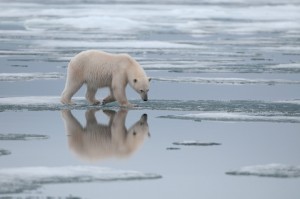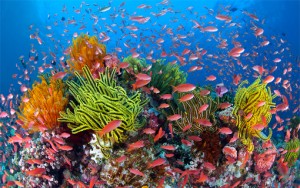Global Warming has adverse effects on the biodiversity of the world in various ways. Biodiversities such as coral reefs, oceans, forests are all threatened. According to the United States Environmental Protection Agency (2013), the climate has an imperative environmental influence on biodiversity or ecosystems.
1. Biodiversity in the Arctic
The average temperatures in the Arctic region are rising twice as fast as they are elsewhere in the world. In addition to this, the Arctic ice is getting thinner, melting and sundering. The National Resources Defence Council (2013) cites an example which is the Ward Hunt Ice Shelf (the largest single block of ice in the Arctic) has been around for 3,000 years before it started cracking in the new millennium, 2000. Since then, it had split all the way through and is now breaking into pieces. To make matters worse, the polar ice cap as a whole is shrinking as observed from NASA satellites. If this trend continues, the Arctic could become ice-free by the end of this century.
That alone, is a colossal amount of damage on the biodiversity in the

http://naturalexposures.com/
Arctic. One would pause and realise that coverage on the inhabitants of the Arctic would stand a slimmer chance of survival if their ‘home’ is destroyed. The World Wide Fund for Nature (2014) also states that a whole ecosystem relies on the presence of sea-ice in the Arctic. The polar bear for instance, is often the first animal that comes to mind whenever an individual is thinking about the Arctic Region. A big white furry polar bear with fish in its mouth. Now imagine with the shrinking of polar ice caps where they stand on to catch their prey, they would have less space to hunt on. They might even freeze to death or drown without adequate ice to stand on or reside in. When that happens, the ‘ecosystem’ or ‘food chain’ within the Arctic is toppled. This also potentially leads to extinction for some of the exotic wildlife species such as the polar bear for instance.
Read a personal account of an inhabitant living near the Arctic region
2. Biodiversity in the Coral Reefs
The warmer air and ocean surfaces temperatures brought on by Global Warming have impacted corals and altered coral reef communities by prompting coral bleaching and altering the chemistry of the oceans.
Firstly, it leads to coral bleaching. Coral bleaching occurs when the corals in the sea are stressed due to their sensitivity to temperature changes. With Global Warming, it brings higher water temperatures that remain for weeks. Such a increase in temperature would lead to the photosynthetic algae ‘zooxanthellae’ (zo·o·xan·thel·la), which the corals depend on for food to leave their tissue. As a result, corals will turn white and unhealthy (or commonly known as bleached). Bleached corals are often weak and less able to combat any disease.
Secondly, it leads to an alteration in the chemistry of the oceans. With Global Warming, more carbon dioxide is emitted. Most of the carbon dioxide that enters the atmosphere dissolves into the ocean. In fact, the oceans have absorbed about 1/3 of the carbon dioxide produced from human activities since 1800 and about 1/2 of the carbon dioxide produced by fossil fuels (Sabine, Feely, Gruber, Key, Lee, Bullister, Wanninkhof, Wong, Wallace, Tilbrook, Millero, Peng, Kozyr, Ono, & Rios, 2004). Ocean acidification occurs when the amount of carbon dioxide in the ocean increases leading to the ocean pH becoming more acidic or decreasing. Such acidification can damage or destroy corals. Researchers also staunchly state that if humans continue to emit carbon dioxide at this current rate, future atmospheric carbon dioxide will be high enough to lower ocean surface pH to 7.8 by the year 2100 which may cause coral reefs to fall apart (Fine & Tchernov, 2005). If destruction of the coral reefs occur, vital habitat will be lost too including the marine organisms. Tropical marine life can go extinct as a result.
Overall, Global Warming has adverse negative impacts on the Corals and can impact favourite tourist locations such as ‘The Great Barrier Reef’ in Australia, and can lead to a loss to a member of ‘The Seven Natural Wonders of the World’. Loss of ecosystems within the corals are just a physical aspect of it. Even more damaging, is the loss of a beautiful nature habitat.

“There, look at how exotic such a natural creation is.” – Bryan
